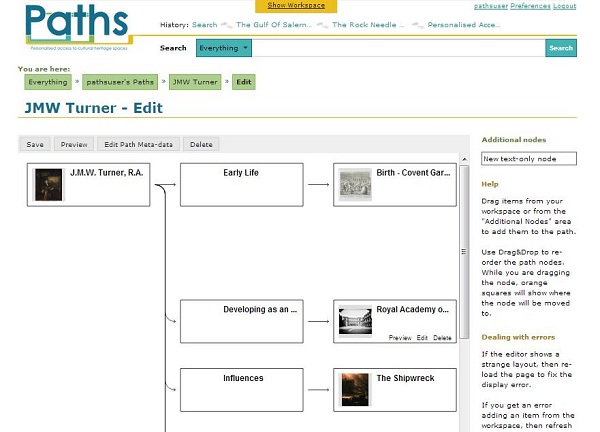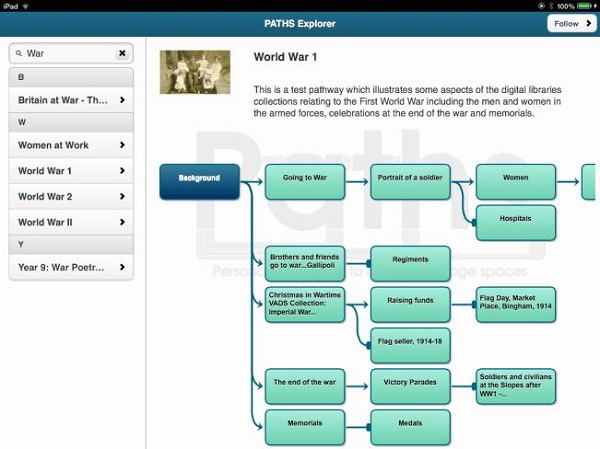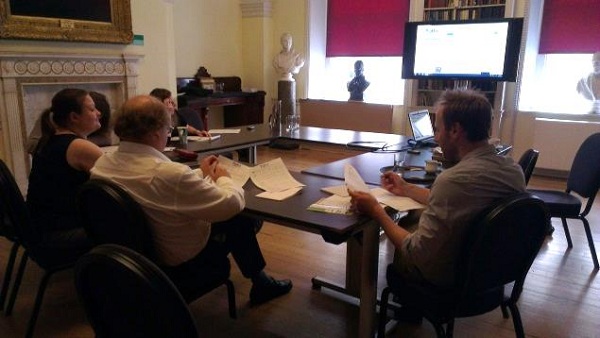By Jill Griffiths, MDR
This blog is written as the PATHS project draws to a close. We started our work three years ago in the context of the significant amounts of cultural heritage material that have been made available through online digital library portals as a result of digitisation initiatives in recent years.

PATHS on the desktop
Such large collections can be difficult to navigate for many users, especially those who lack specialist knowledge about the content or structure of the collection. The metadata that is available can limit the information retrieval that cultural institutions are able to offer their users.
In collections where content is aggregated from many institutions (such as Europeana), creating metadata using diverse cataloguing systems compounds these issues. PATHS aimed to demonstrate the potential for improving users’ experience of exploration and discovery within cultural heritage collections by exploiting natural language processing to enrich metadata and by implementing state-of-the-art systems in user-driven information access.
One of the major achievements of the PATHS project has been to demonstrate the practical benefits and technical feasibility of enriching the metadata for cultural heritage collections as a means of improving content retrieval, supporting innovative discovery and exploitation. This addresses a critical issue for cultural heritage institutions across Europe who hold vast quantities of quality content in digital libraries that are currently never found unless explicitly sought. The initial deployment of PATHS focussed on browser-based applications on desktops. To demonstrate the flexibility of the PATHS API, the project developed a version of the application for use on iPADs.
PATHS on an iPad
Positive feedback from users involved in the evaluation of the PATHS prototypes confirmed that the project achieved its objective of developing tools that add value to digital libraries and enrich user experiences. The interactivity offered by PATHS tools and the potential for expert and non-expert users to use content to create narratives, tell stories and make personal collections has the potential to have real impact on the development of the next generation of cultural heritage services.
The project has provided an important test bed for Europeana content and the Europeana Data Model (EDM) making recommendations on extensions to the EDM schema to manage semantically enriched content. PATHS also made a significant contribution to research into the application of semantic enrichment techniques to cultural heritage content, demonstrating the potential to enrich the simple content metadata to enable novel browsing and information discovery. The techniques used enriched items with links to similar content, created links to related Wikipedia articles, and enabled the collections to be thematically organised into a semi-automatically created hierarchical structure. We explored the potential of generating personalised recommendations based on user profiles, query logs and the similarity of content items, contributing to research in this important area.
Additionally, the knowledge developed through the project with regard to information retrieval, indexing and Web APIs have been invaluable to the development of the next generation of portals. A prototype content enrichment web service was released and has been adopted for development by the LoCloud project. The next generation of Avinet's map portal, ADAPTIVE, is being built exploiting PATHS technology in its search engine and is a first step on the way towards commercial exploitation of PATHS products.
Users within cultural heritage organisations
Throughout the project PATHS has researched, developed and evaluated techniques to improve the presentation of digital library content to end users. Using a robust and holistic requirement and evaluation programme, we developed an understanding of user profiles, needs and requirements and brought this user focus into the development cycle. Our research activities have led to scientific publications, and the project results form a core technology with expectations for further exploitation in the Cultural Heritage domain. We hope that the knowledge developed through the project will be invaluable in the development of the next generation of portals.



